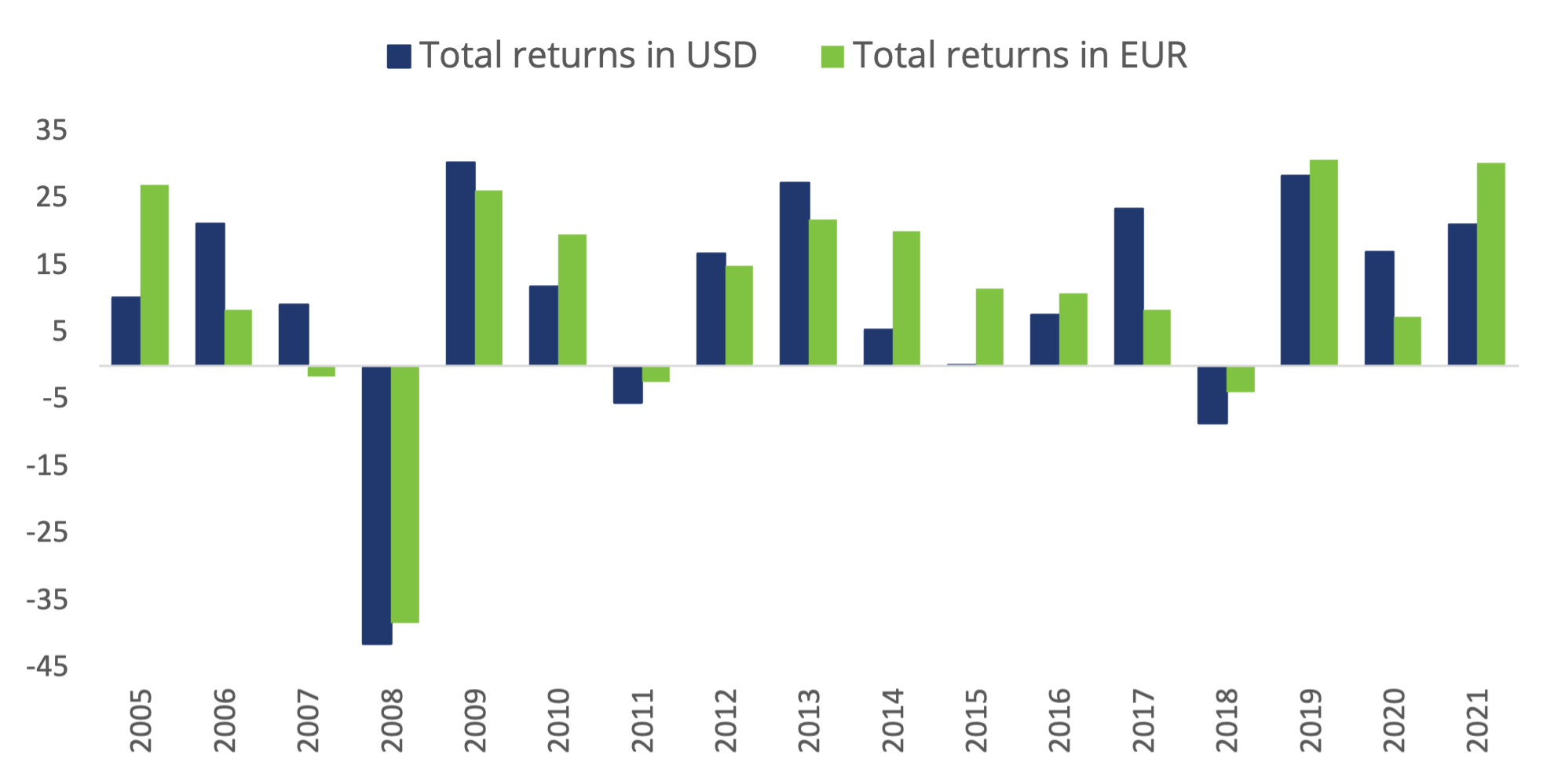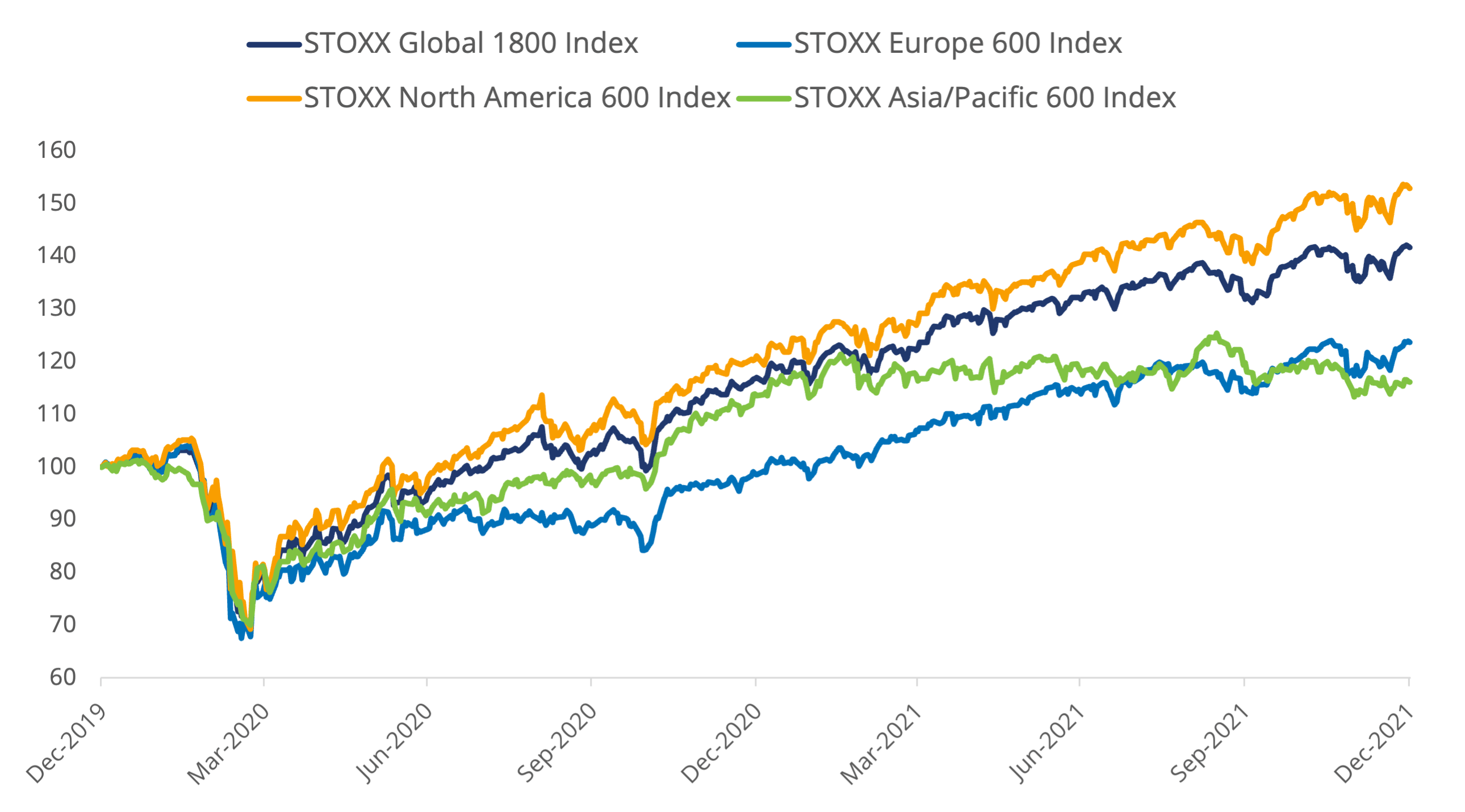
Stocks rose in December and wrapped their third consecutive year of double-digit gains, as fears of economic disruption stemming from the Omicron coronavirus variant abated.
The STOXX® Global 1800 index posted a total return of 4.3% during last month when measured in dollars, and gained 21.1% for the whole of 2021.1 The index rose 3.2% in euros in December as the greenback fell 1% against the common currency.
The pan-European STOXX® Europe 600 index climbed 5.4% in euros to a record during the month, while the Eurozone’s EURO STOXX 50® index increased 5.8%.2 The STOXX® North America 600 index rose 3.9% in dollars and the STOXX® Asia/Pacific 600 index added 2.4%.
Figure 1 – Benchmark indices’ December risk and return characteristics

For a complete review of all indices’ performance last month, visit our December index newsletter.
The STOXX Global 1800 posted in 2021 its third consecutive double-digit annual advance and has now gained in nine of the past ten years. Returns have amounted to an average of 13.9% per year over the last decade.
Figure 2 – Annual % returns for STOXX Global 1800 index

Investors took courage in December after results showed that the Omicron variant is more contagious than previous types but leads to significantly lower levels of hospitalizations and deaths. In spite of lockdowns, ongoing travel restrictions and supply-chain bottlenecks, the STOXX Global 1800 index is now 37% higher than its pre-pandemic peak in February 2020, and has more than doubled in value since the trough in March 2020.
Figure 3 – Returns since January 1, 2020

Volatility drops
The EURO STOXX 50® Volatility (VSTOXX®) index, which tracks EURO STOXX 50 options prices, slumped to 19.3 at the end of last month from 30.1 in November. A higher VSTOXX reading suggests investors are paying up for puts that offer insurance against stock price drops. The index climbed to 86 in March 2020 as governments restricted work and social activities.
Developed and emerging markets
All but one — Hong Kong — of 25 developed markets tracked by STOXX advanced during December when measured in dollars. The STOXX® Developed Markets 2400 index gained 4.2% in dollars and 3.2% in euros.
Seventeen of 21 national developing markets rose in the month on a dollar basis. The STOXX® Emerging Markets 1500 index climbed 4.3% in the US currency and 3.2% in euros.
Food, beverage and tobacco on top
All but two of 20 Supersectors in the STOXX Global 1800 gained in the month. The STOXX® Global 1800 Food Beverage and Tobacco index (9.3%)3 yielded the best return. At the other end, the STOXX® Global 1800 Automobiles & Parts index fell 1.6%.
Value rebounds
Value was December’s best-performing signal among factor strategies covering global markets, while Momentum struggled to catch up, according to the STOXX Factor indices. For 2021, Multi-Factor was the strongest strategy and Size the poorest one.
Figure 4 – STOXX Factor (Global) indices’ December risk and return characteristics

ESG-X and ESG integration indices
The STOXX® Global 1800 ESG-X index rose 4.2%. The STOXX® ESG-X indices are versions of traditional, market-capitalization-weighted benchmarks that observe standard responsible exclusions of leading asset owners.
Within indices that combine exclusions and ESG integration, the EURO STOXX 50® ESG index outperformed its benchmark by 20 basis points during December and by over 3 percentage points during the entire year. Germany’s DAX® 50 ESG index (4.8%), which excludes companies involved in controversial activities and integrates ESG scoring into stock selection, underperformed the benchmark DAX® (5.2%) in December.
Sustainability indices
Among other STOXX sustainability families, the STOXX® Global 1800 ESG Broad Market index gained 4.6% in December. The STOXX ESG Broad Market indices apply a set of compliance, product involvement and ESG performance exclusionary screens on a starting benchmark universe until only the 80% top ESG-rated constituents remain.
Next, the STOXX® Global 1800 ESG Target index added 4.2%, the EURO STOXX® ESG Target index climbed 5.1% and the DAX® ESG Target rose 4.7%. The STOXX and DAX ESG Target indices seek to significantly improve the benchmark portfolio’s ESG profile while mirroring its returns as closely as possible. The indices implement, through a series of constraints, an optimization process to maximize the overall ESG score of the portfolio while constraining the tracking error to the benchmark.
Finally, the STOXX® Global 1800 SRI index jumped 5.7%. The STOXX SRI indices apply a rigorous set of carbon emission intensity, compliance and involvement screens, and track the best ESG performers in each industry group within a selection of STOXX benchmarks.
Climate benchmarks
The STOXX Paris-Aligned Benchmark indices (PABs) came behind their benchmarks in the month that ended. The STOXX® Global 1800 PAB index gained 4.1%. For the entire year, the PAB indices covering the US outperformed while those covering Europe underperformed. The PAB indices follow the requirements outlined by the European Commission’s Technical Expert Group (TEG) on climate benchmarks.
The STOXX® Willis Towers Watson World Climate Transition Index rose 4% in December. The STOXX Willis Towers Watson Climate Transition Indices (CTIs) were introduced in October 2021. They employ a unique Climate Transition Value at Risk (CTVaR) methodology that quantifies the anticipated impact of an economic transition on equity valuations. The CTIs look beyond carbon emissions and make a forward-looking, bottom-up evaluation of asset repricing risks in a decarbonization pathway.
Among the STOXX Low Carbon indices, the EURO STOXX 50® Low Carbon index (6%) beat the EURO STOXX 50 by 17 basis points in December but trailed by 40 basis points for the entire 2021. Elsewhere, the STOXX® Global Climate Change Leaders index (4.7%), which selects corporate leaders that are publicly committed to reducing their carbon footprint, returned 43 basis points more than the STOXX Global 1800 index last month, extending its outperformance in 2021 to 4.7 percentage points.
Thematic indices
The STOXX® Thematic indices had mixed performances last month. The indices seek exposure to the economic upside of disruptive global megatrends and follow two approaches: revenue-based and artificial-intelligence-driven.
Nine of 22 revenue-based thematic indices beat the STOXX Global 1800 index during December, while only seven did so during the whole of 2021. The STOXX® Global Next Generation Telecoms index was the month’s best performer after adding 6.8%. The STOXX® Global Smart Cities index lost 2.7%.
Among the STOXX artificial-intelligence-driven thematic indices, the STOXX® AI Global Artificial Intelligence index climbed 3.7%.
Dividend strategies
Dividend strategies had a strong showing during December, narrowing their underperformance for the whole year. The STOXX® Global Maximum Dividend 40 index (7.8%) selects only the highest-dividend-yielding stocks. The STOXX® Global Select Dividend 100 index (6%), meanwhile, tracks companies with sizeable dividends but also applies a quality filter such as a history of stable payments.
Minimum variance
Minimum variance strategies had strong returns in US markets last month, relative to benchmarks, but those covering Europe underperformed slightly. The STOXX® Europe 600 Minimum Variance index rose 5% in December, while its unconstrained version added 5.2%.
The STOXX Minimum Variance Indices come in two versions. A constrained version has similar exposure to its market-capitalization-weighted benchmark but with lower risk. The unconstrained version, on the other hand, has more freedom to fulfill its minimum variance mandate within the same universe of stocks.
1 All results are total returns before taxes unless specified.
2 Throughout the article, all European indices are quoted in euros, while global, North America, US, Japan and Asia/Pacific indices are in dollars.
3 Figures in parentheses show last month’s gross returns.



